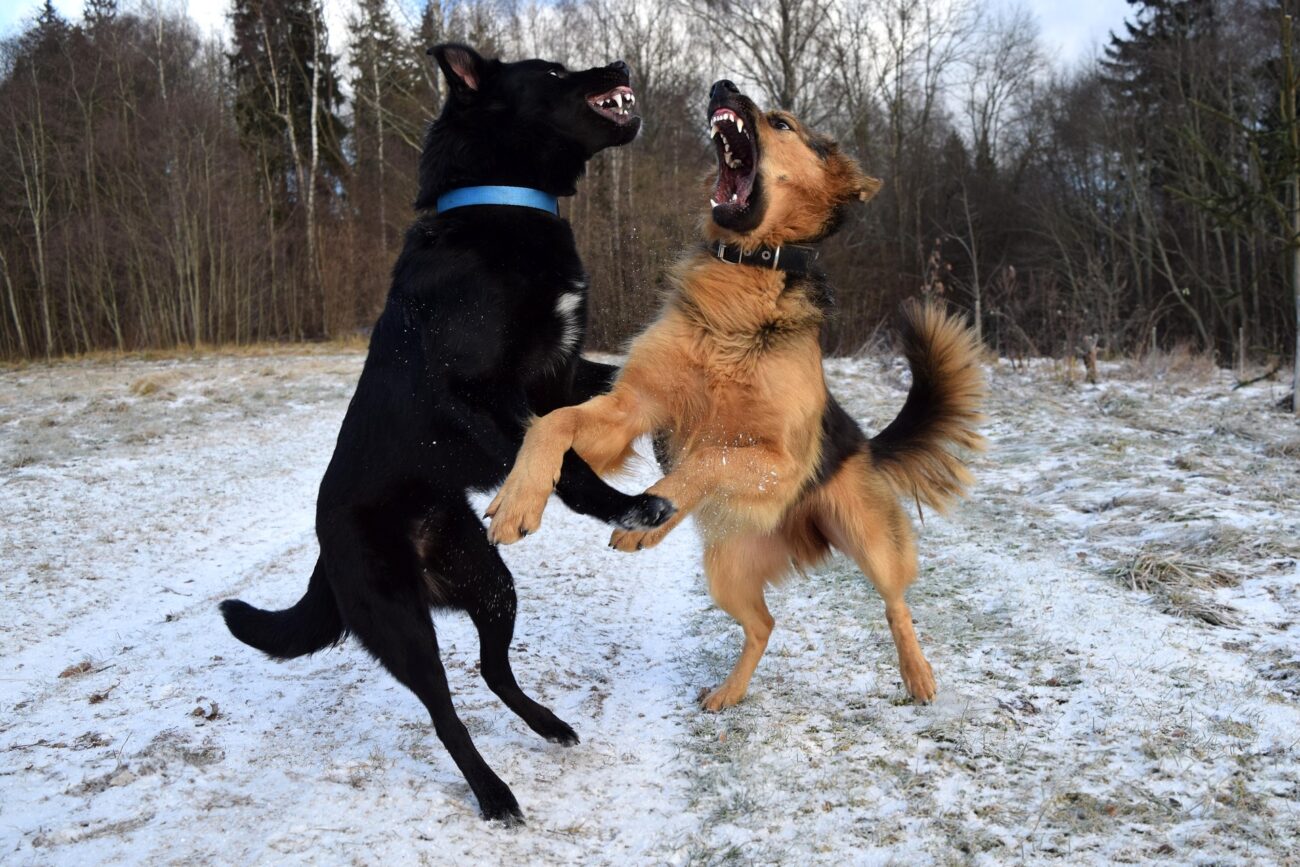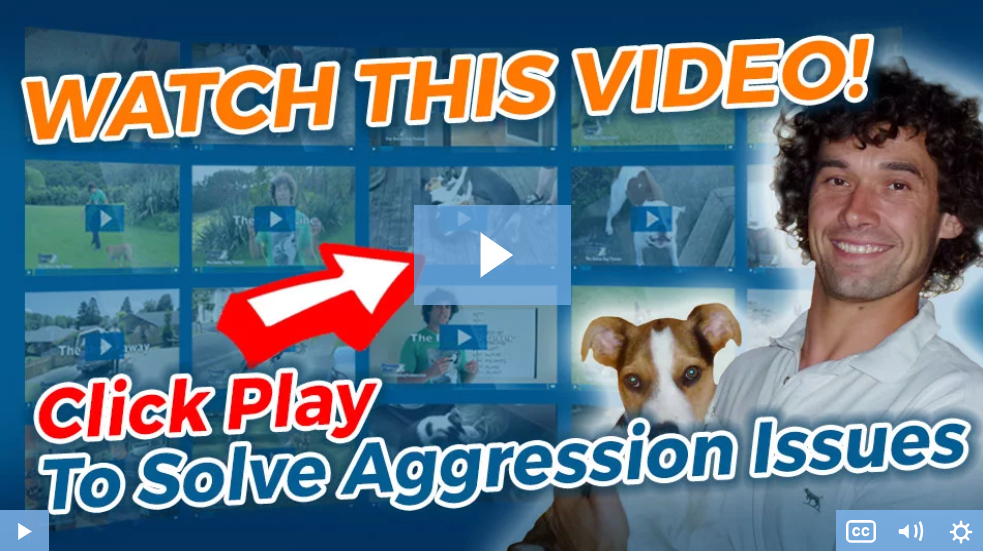Over the past few years, I’ve lost count of the number of emails I get about dealing with dog-on-dog aggression. But today, I want to touch base on one of the more common questions I had recently, which is… “Why does my dog keep attacking my other dog for no reason?”
It’s sad to say, but we don’t live in a perfect world. And while we’d all like nothing more for our dogs to be BFFs (best friends forever), the fact is that it’s not always going to be as smooth sailing with two dogs living in the same household.
Now, nobody wants to see their loveable bundles of joy getting into fisticuffs at every available opportunity.
But unfortunately, it happens so often that it can feel like a constant battle to make sure your gentle, sweet pooch isn’t on the receiving end of an unprovoked attack.
Not only that, but it can put a huge strain on the relationship you have with your dog which can (in some circumstances) result in expensive behavior training, rehoming your dog, or in worst-case scenarios, euthanasia.
I speak from personal experience when I say that nobody deserves to go through this frustration. So it’s essential to try and steer your dog away from this unpleasant behavior before the unthinkable happens.
The good news is that there is a very specific way you can teach your dog to remain calm in any situation that triggers their aggression.
Better still, it has nothing to do with outdated and often forceful training methods. And instead, involves a few tried and tested calming techniques that will make your dog highly responsive and relaxed.
Now, I can’t take all the credit for these exercises because the truth is, I actually picked them up from Dan Abdelnoor (aka Doggy Dan) over at The Online Dog Trainer in the video below.
But over the years, these specific calming techniques have proven themselves time and time again when it comes to calming the aggressive nature in dogs.
Better still, they take just minutes a day to apply.
Anyway, if you want to see what these exercises are, and how they can calm your bundle of joy from a life of aggression, go ahead and watch the short video below where Dan reveals all.
Here’s the video link to take a look: Click Here To Discover How To Finally Stop Your Dogs Unprovoked, Aggressive Attacks Using Simple, Highly Effective Calming Exercises That Take Just Minutes A Day To Implement!
(video will open in a new window)
Why Do Dogs Attack?
Before we get started it’s worthwhile just covering a few basics on the nature of canine aggression and how to spot it.
Contrary to much popular opinion, certain breeds of dogs are not automatically prone to expressing aggressive behavior towards others.
Just like humans, dogs all have their own personalities, and their early socialization and training will play a large part in how they behave over their lifespan.
The real problem with dog-on-dog aggression issues comes down to size.
Larger dogs are going to be capable of inflicting serious damage on others – especially when they attack spontaneously and catch the other unaware.
But regardless of breed, most dogs will clearly show an inclination and readiness for violence in similar ways. they will…
- Become stiff and raise their haunches ready to pounce.
- Snarl, growl, and display the whites of their eyes.
- Display their teeth.
- Often start with a nip followed by a full-on attack.
- ‘Dry snap’ in anticipation of a bite.
When you see your dog exhibit these towards the other, you must separate them right away.
Allow the aggressor time to cool down and carefully reintroduce them a couple of hours later.
Chances are – and this is where it becomes frustrating – everything will appear absolutely fine again.
But there is a serious risk that this will begin again and you may not be present to intervene before the attack takes place.
So what causes dogs to attack their packmates?
Here are the most common reasons, just remember that it could well be a combination of the following…
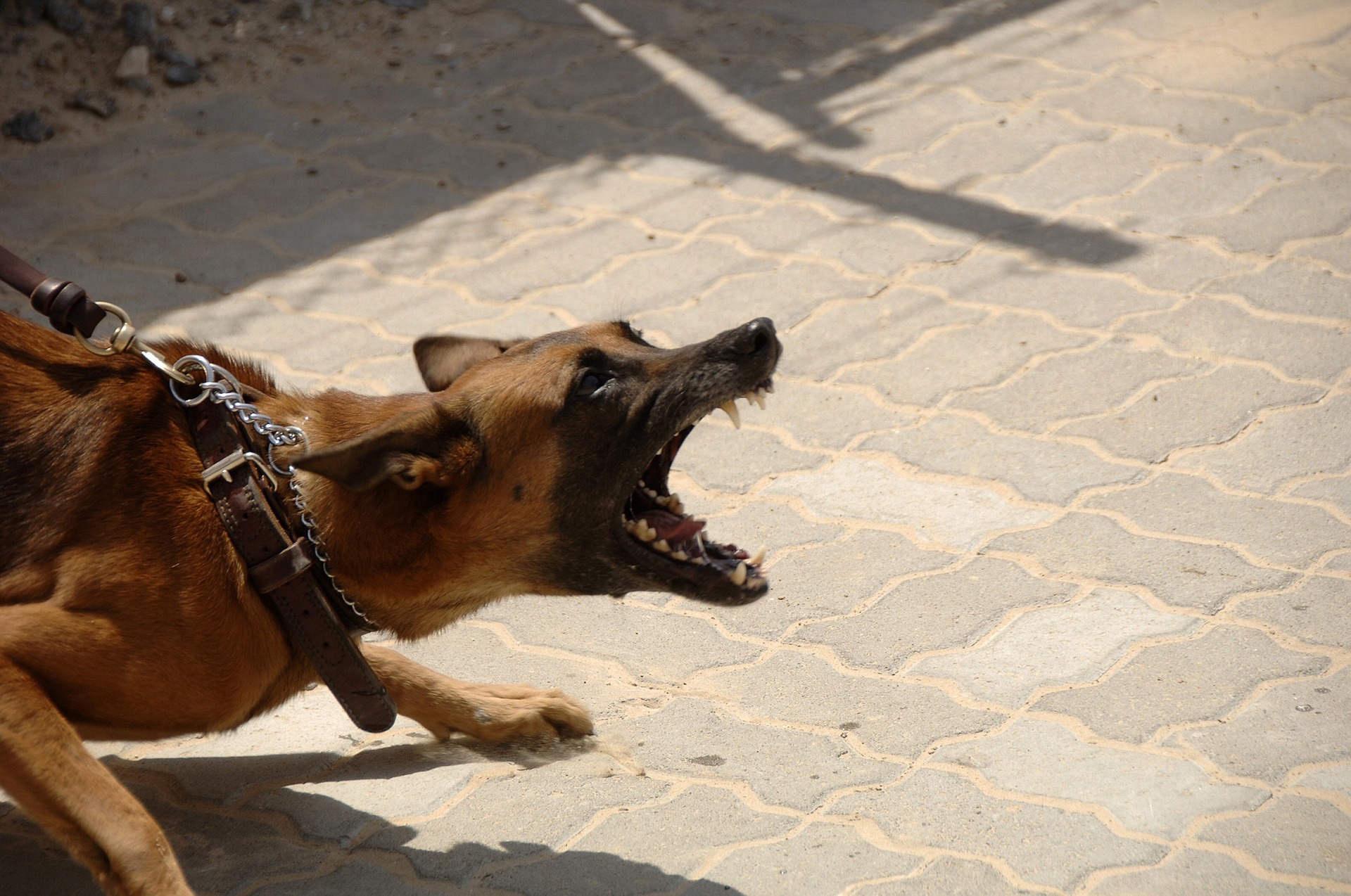
#1 – Domination Aggression
Hierarchy is extremely important to dogs.
In the wild, it establishes a ‘pecking order’ of who gets to eat first.
Regardless of which member made the kill, the Alpha’s eat first and the rest are left to fight over the scraps.
So deciding who goes first – and who is entitled to the larger share – is established by fighting.
Alien as it may seem to the average dog owner, these instincts are retained by all dogs and tend to be the main reason why one member may become aggressive against another.
At more extreme levels they may even challenge your authority if they are allowed to continue this behavior unchecked.
Remember that while food is by far and away the most common cause of this problem, it may also refer to a number of other privileges or advantages.
Dogs may become aggressive against a calmer packmate over wishing to dominate favored sleeping spots, toys/puzzles, and even your affection.
This is often referred to as possession aggression.
#2 – Jealousy Aggression
This can become especially prominent – and dangerous – when a puppy or younger dog is introduced to a formerly one-dog household.
It can be difficult for established dogs who may have enjoyed years of devoted attention to suddenly observe that some imposter now receives the love that they assume would otherwise have been directed towards them.
Even if you go out of your way to maintain playtimes and exercise exactly as they were before, your dog will still not necessarily be keen to share.
A jealous dog is by no means necessarily a ‘nasty’ dog.
Do not forget that they see the world very differently to how we do, and even well-socialized dogs who have no problem encountering others during walks/visits may become aggressive if that becomes intrusive on their territory.
Such frustration is difficult to identify but often tends to be a motivation behind seemingly irrational spontaneous attacks.
#3 – First Strike Aggression
Fear is another common cause of aggression between packmates.
Dominant dogs – who may often be considerably older and not in quite as good condition as they once were – may see their status under threat.
The logical step would be to literally nip that problem in the bud before it becomes one.
This can be by attacking the potential rival while they still can.
When introducing new dogs to the pack you must keep a very close eye out for this as it can occur at any time.
To spot this problem you must understand that resident dogs will take a little while to assess the new arrival first.
Just because they have a ‘doggy handshake’ (sniffing faces, looking up and down) does not by any means imply that everything is fine.
As the first days pass your established pooch may well take objection to the newbie settling in their possessed spaces and playing with their toys.
Sometimes they will roll with it, and other times they will attack without warning.
WATCH VIDEO: Discover How To Finally Stop Your Dogs Unprovoked, Aggressive Attacks Using Simple, Highly Effective Calming Exercises That Take Just Minutes A Day To Implement!
(video will open in new window)
#4 – Redirected Aggression
Perhaps the trickiest form of canine aggression to assess, redirected aggression occurs when your dog is so frustrated about something that is out of their control that they simply have to let off steam.
They are unlikely to attack their pack leader, but a fight is a sure way to release all that pent up stress, frustration, and aggression.
Your other dog will likely be as bemused as you for why they have suddenly become attacked by their packmate.
Figuring out what is causing this can be a longwinded problem.
The obvious first considerations would be along the lines of…
- Are they receiving enough exercise?
- Has there been an environmental change?
- Are they in physical pain?
- Are they being fed enough?
When it is clear that all of these essential needs are being met, it may be time to consult with a local behavioral expert.
Just like us, dogs can suffer mental imbalances that may occasionally make them more prone to unpredictable and aggressive actions.
#5 – Socialization Aggression
As outlined above, socialization is a learned trait that requires regular reinforcement throughout the dog’s life.
Regular and routine exposure to other people and dogs will in the vast majority of cases limit inherent aggressive tendencies.
However, not all dogs socialize in the same way and sadly many are poorly kept as youngsters and never become comfortable in their own skin.
Sometimes this will manifest itself in aggressive tendencies that can be highly unpredictable.
And while they may never display aggression towards humans, other dogs may be ‘fair game’.
One common example would be when rehoming a dog that has a troubled background into a comfortable family.
From our perspective, the dog ought to feel like it has gone to paradise compared to the dingy kennel where they may have lived for many months.
But in reality, it is never that simple.
Such dogs may immediately be confused, severely anxious, and the natural reaction is for them to assert control over their environment.
To make this matter more troubling (and speaking from personal experience) it may take many months for this to materialize.
You can also see a great example of how to solve this issue in the video below…
Dangers Of Dog On Dog Aggression
Most pairs of dogs (unless they are mature or very well trained) are going to play together and it can be surprisingly difficult to know when to call Time Out on their roughhousing.
Puppies in particular often do not know their own strength, and playing is one of the ways whereby they establish appropriate limits.
Intervening during such playtimes can – strange as it might sound – be counterproductive in the longer term.
Likewise, mature dogs can take and enjoy quite rough playtimes and that is something that you need to personally manage.
The problem though is when one dog attacks another out of sheer aggression. As this can usually catch the other unawares and cause real injury.
Remember that the attacked dog is going to defend itself and will also reciprocate with usually extreme violence.
So before you know it, there is a strong chance you will have two badly hurt dogs requiring medical care.
Not to mention the fact that they are also unlikely to ever trust each other again.
Almost inevitably this will result in you needing to rehome one or both of your dogs.
And with millions of dogs already cluttering up the rehoming services, there is little prospect for a dog with an aggressive history avoiding euthanization.
Harsh as it sounds, that is the reality.
If left unaddressed there is no reason why your aggressive dog will not get their own way, especially if they are physically dominant.
Once they have bossed their packmate into submission, the next obvious step is to challenge for the Alpha spot.
Their first target will potentially be children, and then they’ll work up towards adults. Once again this is no exaggeration.
It does happen and there is no reason why it may not happen to you.
Allowing one dog to fight/bully another is a surefire way to destroy harmony within the pack.
Failing to take action immediately will lead to a lack of respect for your authority, and that can be extremely difficult to regain.
Fortunately, there are tried and proven methods that can be extremely effective in eliminating this problem and ideally even preventing it in the first instance.
Related Post: My Dog Is Aggressive Towards Me But Not My Husband
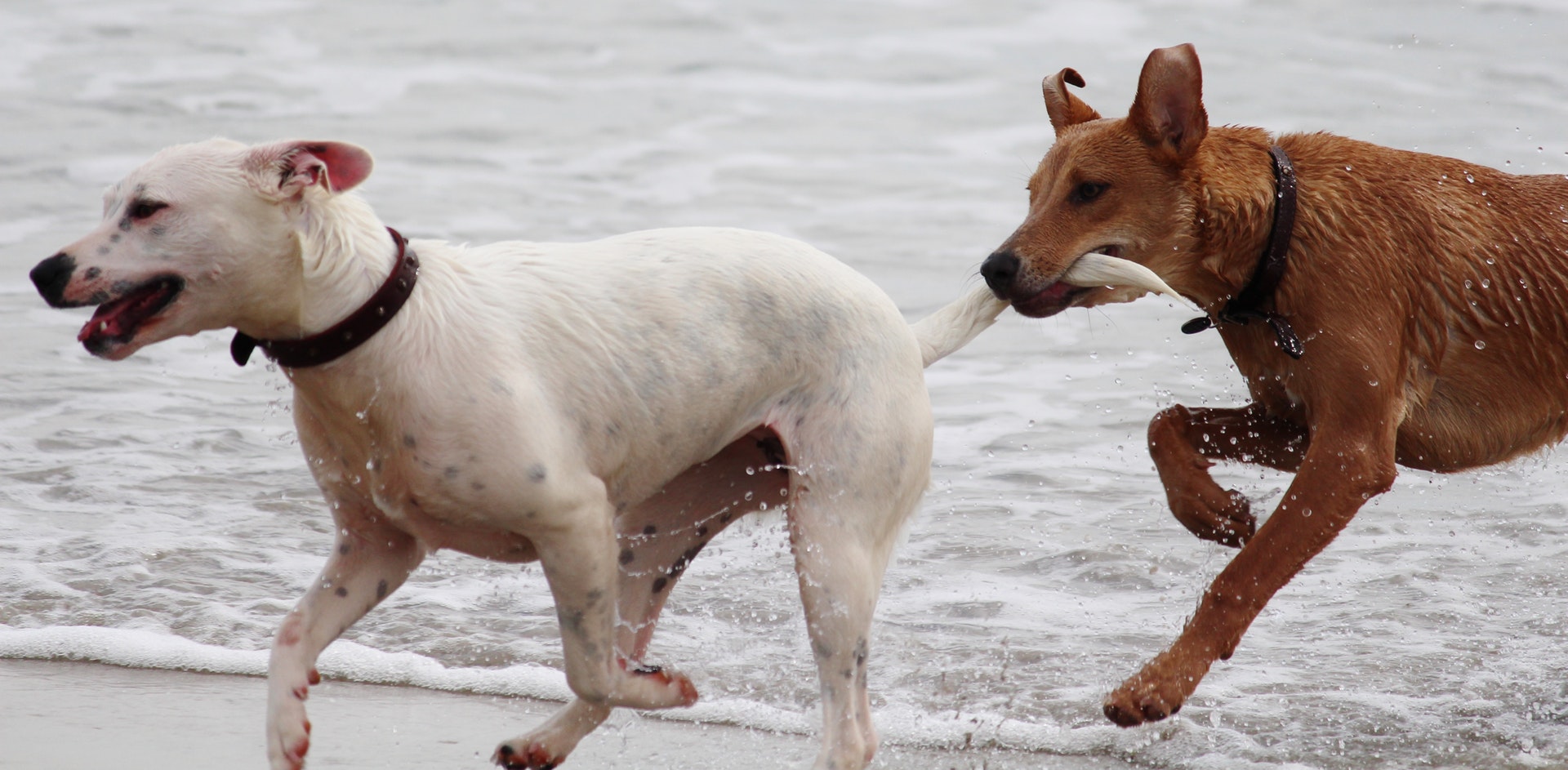
How To Stop My Dog Attacking My Other Dog
OK, so you are worried that your dog is behaving aggressively towards their packmate…
…Or maybe they have already demonstrated some violent tendencies.
Most decent canine behaviorists will explain that the cornerstone of treating these tendencies is behavior modification therapy.
Do bear in mind that sometimes this treatment can be dangerous, especially if the problem is severe and they have already badly mauled another dog.
Even the smallest dog can bite hard, and larger breeds can be life-threatening. So it is sensible to seek advice from an accredited expert who can assess the exact nature of your situation.
That being said, for any treatment to be effective you must play a very important role.
So here’s what you need to do…
#1 – Avoid Punishment
Aggression between your dogs is extremely horrible and even the coolest-headed person may feel the need to scold and even physically reprimand the aggressor.
To be honest with you, they probably deserve it. But understand that by doing so you are just going to make the problem worse.
Immediately after an incident, you must remove the aggressive dog and keep them isolated from the other.
This will allow time for everyone to calm down and then assess what action must be taken.
Chances are that the dog who has been attacked may be hurt yet psyched up and ready to engage again regardless.
So allow them time to settle (they may irrationally bite) and seek medical services if needed.
#2 – What Went Wrong?
This is where an expert may be useful as it can be difficult for many owners to notice or appreciate what is causing the problem.
Very few dogs are naturally spontaneously violent so you should first look for what might have caused the trigger.
For example, if they are both trying to monopolize one toy – consider buying another.
It really can be that simple!
More likely it will be something to do with territory or food. Both of which can be effectively solved using essential socialization and behavioral techniques.
Whatever the cause of the problem, be ready to start back from the basics as you need to consider this as a slate to be wiped clean.
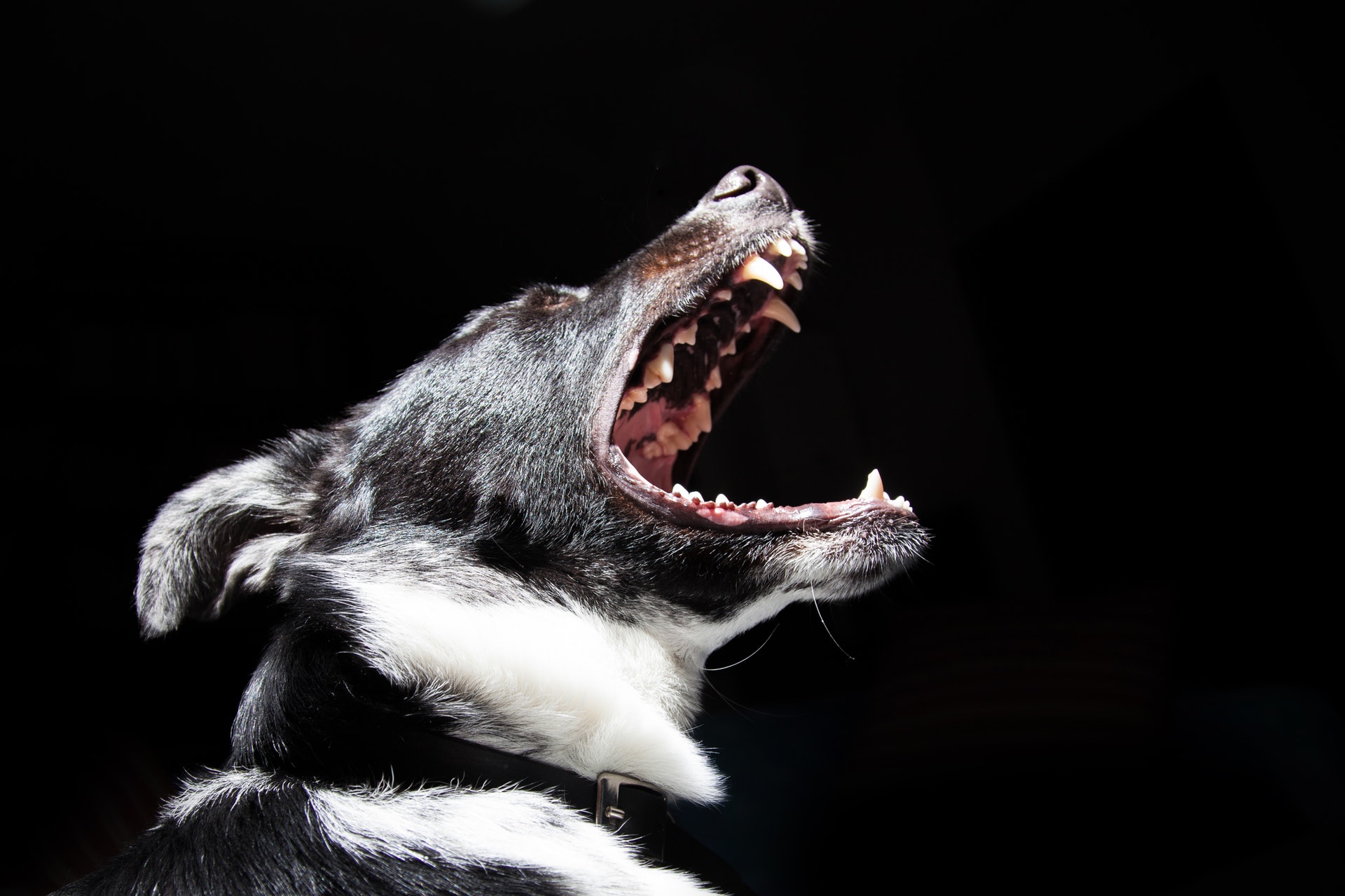
#3 – Re-establish Yourself As Pack Leader
Dogs which attack others have in the overwhelming majority of cases forgotten who is the Boss.
Older dogs may be complacent and start to view you as a fleshy can-opener.
And younger dogs may yet to be convinced that you demand their respect.
So establishing boundaries for their behavior is critical. And sticking with these consistently will almost always result in earning their trust and obedience.
And remember, these rules are for their entire life and without any compromise.
In a nutshell, you want your dogs to respect you because they understand that you have their best interests at heart.
In the wild, dogs may fight between themselves for their position in the hierarchy but will stop the moment that an Alpha intervenes.
Their very presence nearby is usually enough to see other members act submissively between each other.
That is exactly what you are trying to achieve.
And considering that it’s you that visits the store every day for food, treats, and toys instead of having to chase down a fleeing deer, it really shouldn’t be too difficult!
So by following one of the many good guides to establishing and maintaining pack leadership will play a huge role in restoring order.
#4 – Carefully Reintroduce
It is generally a good idea to keep your dogs apart for a short while – say a couple of days – after a bad fight but this depends on the circumstances and your situation.
This ought to allow enough time to establish what the problem might be and figure out a plan of appropriate action.
It is a good idea to begin reintroduction with both dogs on the leash.
Once they seem comfortable (sit with them for half an hour) take them out for a walk that will provide distractions from each other.
Once it comes to feeding time, carefully monitor and perhaps feed them independently to start with should possessiveness be the problem.
During playtimes, keep the aggressive dog on the leash and allow the other to play as normal.
Only then, should you carefully let them get to know each other again.
Now, this it is easier said than done and the ‘gently, gently’ approach is the only sensible path to take.
At bedtime and during other unsupervised moments you will need to use their crates.
Should the aggression be seriously mismatched…
- A large dog attacking a smaller one.
- Or an older picking on a youngster.
You may want to look into more specialist advice and training.
In this case, you may want to revisit socialization training from scratch and above all, make it clear who the boss is.
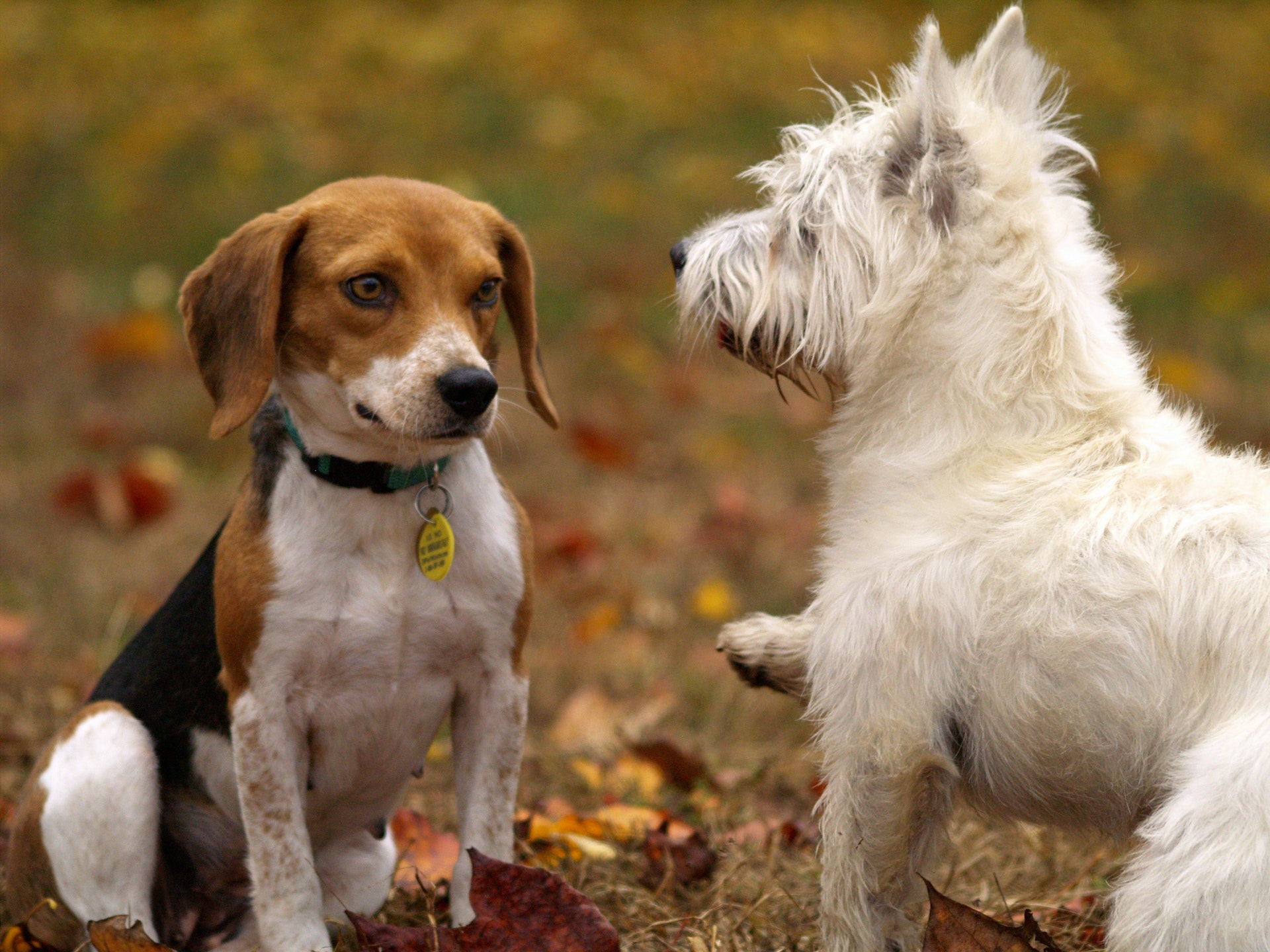
Final Thoughts
Under no circumstances should any responsible owner even consider using shock collars or similar brutal ‘training’ devices.
Not only to such aversion techniques not work, but they’ll also make matters even worse.
Some veterinarians may suggest using pheromone treatment which can sometimes help make dogs less prone to violent reactions, but there is absolutely no certainty that they will work.
From experience, I’d rate them only being potentially beneficial when used in conjunction with retraining and resocialization methods.
How far they actually contribute towards that is a very ambiguous question.
Professional help (make sure they are accredited and specialize in canine aggression) can make all the difference.
Simply having the opinion of someone detached from your circumstances and simply looking at it impartially will often result in some highly effective remedial training suggestions.
It is a long and twisty route getting back to being able to trust a dog not to attack another.
But it all depends on how you deal with the situation to establish those behavioral boundaries.
Just do not lose hope – this is far from an unusual situation and in many circumstances, it can be effectively resolved.
Anything you would like to share from your own experiences coping with dog-on-dog aggression in the household?
Feel free to add your tips and advice in the comments below…
WATCH VIDEO: Discover How To Finally Stop Your Dogs Unprovoked, Aggressive Attacks Using Simple, Highly Effective Calming Exercises That Take Just Minutes A Day To Implement!
(video will open in new window)
FAQ’S: Frequently Asked Questions About How To Deal With Random, Unprovoked Attacks…
Question #1…
I’ve taken on board all of the above. But what can I do in the meantime to stop my dogs’ unprovoked attacks towards my other dog while I deal with the situation?
Answer:
That’s a great question. It’s important to remember that no issue of the severity is going to solve itself overnight. So in the meantime, it’s all about damage limitation until you can get matters under control.
It might sound harsh, but temporarily separating your dogs when they’re more likely to engage in a fight should at least help dial things down until things start to get better.
This is where identifying the root cause of your dog’s unprovoked attacks can come in really handy. Because if you can at least reveal ‘when’ it’s happening, you’ll be in a much better position to separate your dogs and limit their interaction where attacks are imminent.
For instance, if you happen to notice your dogs constantly battling it out during mealtimes, set up a doggy gate and feed them in different rooms or at different times until things become more manageable.
Question #2…
I’ve read somewhere about a training technique called counterconditioning. What is it, and can I use it to help keep the peace between my dogs?
Answer:
In a nutshell, counterconditioning is all about replacing any negative associations your dog may have with new ‘positive associations.’
While it might sound a little far-fetched, this training technique can work wonders for building up the positive vibes your dogs have in each other presence.
Basically, it’s all about recognizing when your dog is behaving around your other dog and then rewarding the behavior with positive praise and maybe a few treats.
The idea is that in time, your dog will learn to associate being around your other dog with good things happening, and as a result, act appropriately without lashing out.
It’s important to note that this can take days or even weeks of consistent effort. And it needs to be done gradually to avoid any mishaps.
Also, note that I didn’t say punish or scold your dog for acting badly or when things don’t go to plan. This will often have the reverse effect and slam the brakes on any progress you may have made.
Question #3…
I’m concern that my dog might still attack without warning, even after implementing the techniques Dan discusses in The Online Dog Trainer you mentioned previously. How do I know if it will work for my dog?
Answer…
While the training Dan offers will always be my go-to favorite for dealing with your dog’s behavioral issues. The truth is that a lot of the success you have will depend on your attitude as well.
The training itself will do nothing if you don’t actually apply what’s taught in the course.
But I guarantee that if you follow through with what you learn you’ll be amazed at what’s possible.
